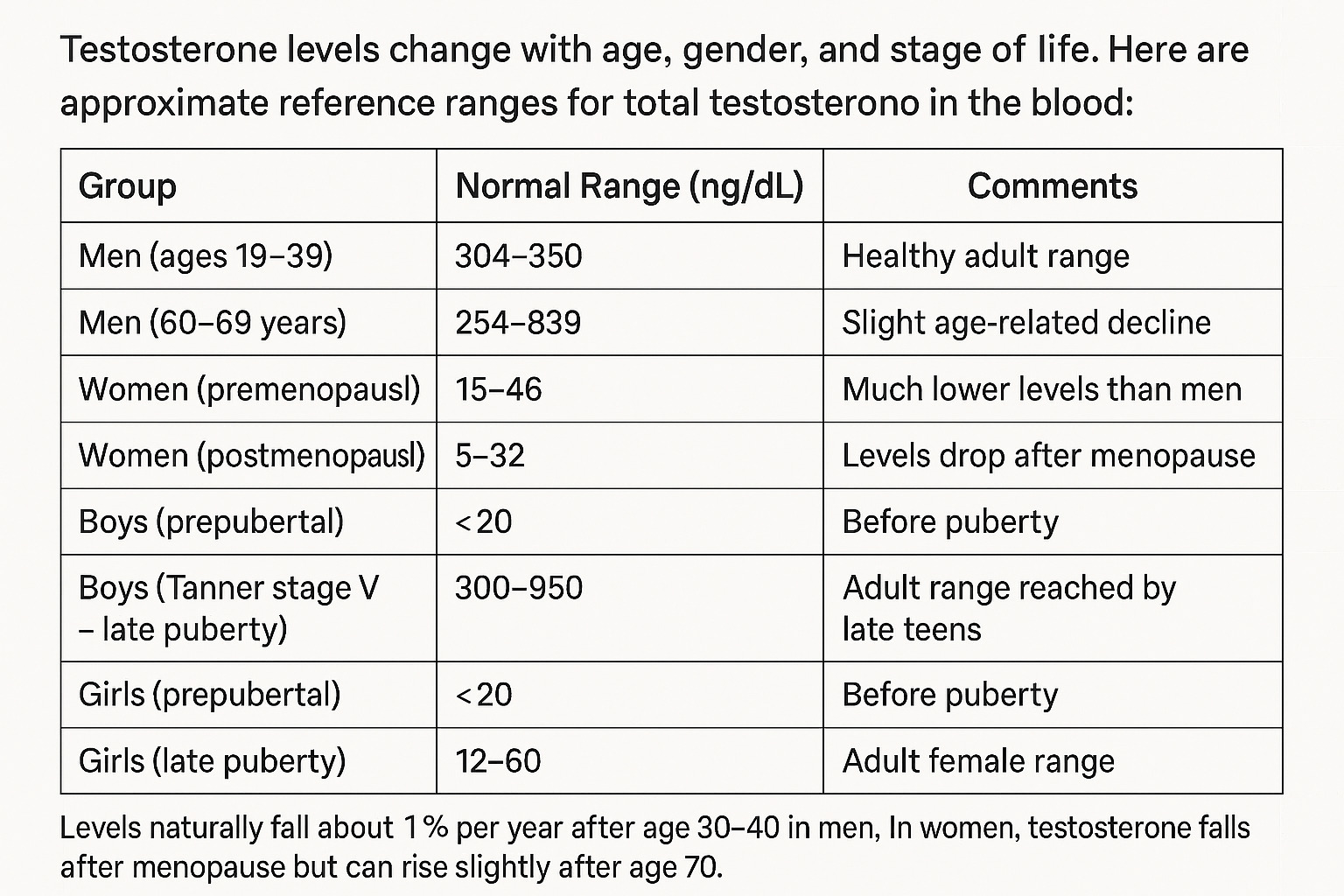Testosterone Testing Levels: Normal, High, Low, Dangerous Levels Explained
Testosterone is the main sex hormone responsible for energy, fertility, and sexual health in both men and women. Abnormally high or low levels can affect almost every organ system—from bones and heart to mood and memory. In this article, we explain what your testosterone test levels mean, what counts as normal, low, or dangerous, and when you should see your doctor for treatment or further evaluation.

What Is Testosterone and Why It Matters
Testosterone is a hormone made mainly by the testicles in men and by the ovaries and adrenal glands in women. It regulates:
- Sexual health – desire, erections, and sperm production.
- Energy and muscle mass – helps build and maintain lean tissue.
- Bone strength – prevents osteoporosis and fractures.
- Mood and memory – influences motivation, focus, and emotional stability.
Levels that are too low or too high can cause serious health problems. The test measures testosterone in nanograms per deciliter (ng/dL). Morning testing (between 7–10 AM) gives the most accurate result because levels fluctuate during the day.
Normal Testosterone Levels by Age and Gender
Testosterone levels change with age, gender, and stage of life. Here are approximate reference ranges for total testosterone in the blood:
| Group | Normal Range (ng/dL) | Comments |
|---|---|---|
| Men (ages 19–39) | 304–850 | Healthy adult range |
| Men (60–69 years) | 254–839 | Slight age-related decline |
| Women (premenopausal) | 15–46 | Much lower levels than men |
| Women (postmenopausal) | 5-32 ng/dl | Levels drop after menopause |
| Boys (prepubertal) | <20 | Before puberty |
| Boys (Tanner stage V – late puberty) | 300–950 | Adult range reached by late teens |
| Girls (prepubertal) | <20 | Before puberty |
| Girls (late puberty) | 12–60 | Adult female range |
Levels naturally fall about 1% per year after age 30–40 in men. In women, testosterone falls after menopause but can rise slightly after age 70.
Low Testosterone Levels (Hypogonadism)
Low testosterone—also called hypogonadism—happens when the body cannot make enough hormone for normal function. This may be due to problems in the testicles, ovaries, or brain signals (pituitary/hypothalamus).
Typical Low-Level Thresholds
| Severity | Testosterone Level (ng/dL) | Meaning |
|---|---|---|
| Mild deficiency | 200–300 | May cause symptoms; confirm with repeat test |
| Severe deficiency | <200 | Definite hypogonadism |
| Critical level | <150 | Requires urgent endocrine evaluation |
| Extremely low | <100 | Possible pituitary tumor or severe testicular failure |
Symptoms of Low Testosterone
- Loss of sexual desire, erectile dysfunction, or infertility
- Fatigue, poor concentration, and low motivation
- Loss of muscle mass and strength
- Weight gain, especially around the waist
- Weak bones and increased fracture risk
- Depression, irritability, or mood swings
In women, low testosterone may cause reduced sexual desire, fatigue, and mood changes—especially after menopause or removal of ovaries. For children, low levels can delay puberty.
High Testosterone Levels and Their Risks
High testosterone may occur naturally, but in most adults it results from testosterone therapy or steroid use. Persistent high levels can be harmful.
When Levels Are Too High
| Category | Testosterone Level (ng/dL) | Possible Risk |
|---|---|---|
| Above normal (monitor) | 900–1200 | Increased red blood cells (polycythemia) |
| Medically dangerous | >1200 | Heart attack, stroke, or clotting risk |
| Emergency (men on therapy) | Hematocrit >54% | Immediate testosterone cessation required |
Common Symptoms and Dangers
- Headaches, dizziness, or blurred vision (from thick blood)
- Acne, oily skin, and hair loss
- Enlarged prostate or urination problems
- Sleep apnea or snoring
- Aggressive behavior or mood changes
- Infertility due to suppression of sperm production
In women, testosterone above 150–200 ng/dL can cause virilization (deep voice, facial hair, enlarged clitoris) and may signal an ovarian or adrenal tumor. This requires urgent imaging and endocrinology consultation.
Children and Teenagers: When Testosterone Is Dangerous
Testosterone is crucial for puberty, but levels that are too high or too low can indicate serious problems.
Low Levels (Delayed Puberty)
- Boys over 14 years old with testosterone below 30 ng/dL and no signs of puberty need evaluation.
- Girls over 13 with no breast development and testosterone remaining below 10–20 ng/dL may have delayed puberty.
High Levels (Precocious Puberty)
- Boys under 9 with testosterone above 100 ng/dL – may indicate early puberty or tumor.
- Boys under 13 with testosterone above 800 ng/dL – requires urgent evaluation.
- Girls under 8 with testosterone above 50 ng/dL – suspicious for early puberty or adrenal disorder.
Rapid physical changes such as voice deepening or rapid growth of pubic hair in children should always prompt medical testing and specialist evaluation.
Testing, Diagnosis, and Monitoring
Proper testosterone testing ensures accurate diagnosis and safe treatment.
How Testing Is Done
- Measure in the morning (7–10 AM) when levels peak.
- Confirm with a second test on another day.
- Use reliable lab methods like LC-MS/MS for accurate results.
Important Related Tests
- LH and FSH – determine if the cause is testicular or pituitary.
- Prolactin – checks for pituitary tumors.
- Free Testosterone and SHBG – measure biologically active hormone.
- Hemoglobin/Hematocrit – monitor for thickened blood during therapy.
Diagnosis of testosterone deficiency requires two low readings plus matching symptoms. Never start treatment based on one test alone.

 By: Dr.Bhargav Raut
By: Dr.Bhargav Raut